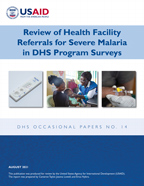- PUBLICATIONS
- JOURNAL ARTICLES
- ACCESS PUBLICATIONS
Publications Summary
- Document Type
- Occasional Papers
- Publication Topic(s)
- Malaria
- Language
- English
- Recommended Citation
- Taylor, Cameron, Joanna Lowell, and Erica Nybro. 2021. Review of Health Facility Referrals for Severe Malaria in DHS Program Surveys. DHS Occasional Papers No. 14. Rockville, Maryland, USA: ICF.
- Download Citation
- RIS format / Text format / Endnote format
- Publication Date
- August 2021
- Publication ID
- OP14
Download
 Review of Health Facility Referrals for Severe Malaria in DHS Program Surveys (PDF, 4422K)
Review of Health Facility Referrals for Severe Malaria in DHS Program Surveys (PDF, 4422K)
Download this publication
There is no printed copy available to order.
